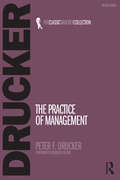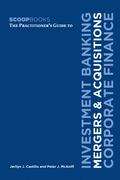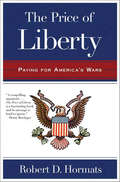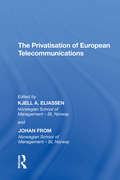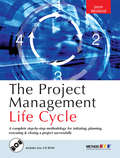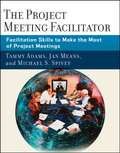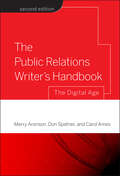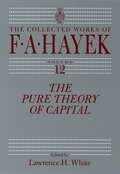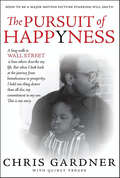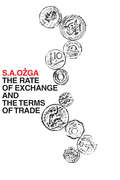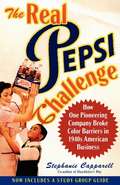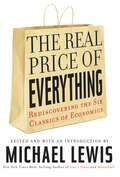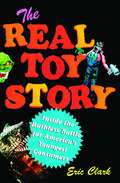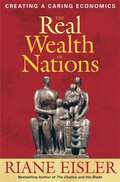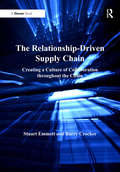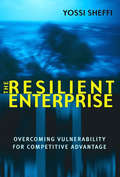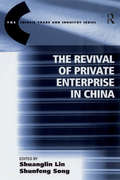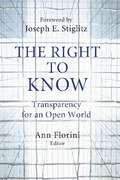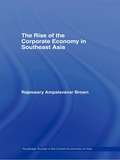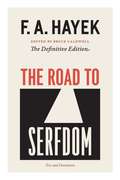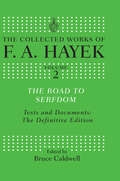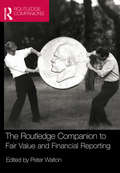- Table View
- List View
The Practice of Management: Management:, Management Challenges For The 21st Century, Managing In Turbulent Times, And The Practice Of Management
by Peter DruckerThis classic volume achieves a remarkable width of appeal without sacrificing scientific accuracy or depth of analysis. It is a valuable contribution to the study of business efficiency which should be read by anyone wanting information about the developments and place of management, and it is as relevant today as when it was first written. This is a practical book, written out of many years of experience in working with managements of small, medium and large corporations. It aims to be a management guide, enabling readers to examine their own work and performance, to diagnose their weaknesses and to improve their own effectiveness as well as the results of the enterprise they are responsible for.
The Practitioner's Guide To Investment Banking, Mergers And Acquisitions, Corporate Finance (Scoopbooks)
by Jerilyn Castillo Peter McAniffTHE PRACTITIONERS GUIDE provides a thorough grounding in mergers & acquisitions and corporate finance for those who want to know more about the world of investment banking. A practical handbook, THE PRACTITIONERS GUIDE presents comprehensive explanations of the analytical processes used to evaluate and structure mergers, acquisitions, divestitures, and capital raising transactions. Finance professionals, corporate attorneys, accountants, corporate development teams and MBAs will find THE PRACTITIONERS GUIDE essential as a resource and desktop companion.
The President We Need: Assess Personality Intelligence to Pick the Best Candidate
by Michael MaccobyCiting history and using psychological analysis, in this chapter the author describes the qualities of a president who would be able to mobilize Americans to meet the tremendous challenges of our time. Since we can't always predict how a president will act from past behavior, he also lists the questions we should ask candidates to discover whether they have the Personality Intelligence we need in a president.
The Price of Liberty: Paying for America's Wars
by Robert D. HormatsIn a bracing work of history, a leading international finance expert reveals how our national security depends on our financial securityMore than two centuries ago, America's first secretary of the treasury, Alexander Hamilton, identified the Revolutionary War debt as a threat to the nation's creditworthiness and its very existence. In response, he established financial principles for securing the country—principles that endure to this day. In this provocative history, Robert D. Hormats, one of America's leading experts on international finance, shows how leaders from Madison and Lincoln to FDR and Reagan have followed Hamilton's ideals, from the greenback and a progressive income tax to the Victory Bond and Victory Garden campaigns and cost-sharing with allies. Drawing on these historical lessons, Hormats argues that the rampant borrowing to pay for the war in Iraq and the short-sighted tax cuts in the face of a long-term war on terrorism run counter to American tradition and place our country's security in peril. To meet the threats facing us, Hormats contends, we must significantly realign our economic policies—on taxes, Social Security, Medicare, and oil dependency—to safeguard our liberty and our future.
The Privatisation of European Telecommunications
by Johan FromThis international volume presents a comprehensive, comparative study of the transformation of the European telecommunications industry from 1990 to the present. The book focuses on the old incumbent operators and their dramatic change from state agencies to listed companies. It analyzes the liberalization process, as well as the corporatization and privatization of these companies. The contributors assess the conditions for the transformations taking place; the driving forces for change; the effects to management, the efforts of the EU during these processes, and ultimately, the role of the private owner. Political science publications have all but excluded analysis of the newly privatized companies; their contribution to the liberalization process both before and after privatization; and the interplay between the national political and company levels. The book redresses this shortcoming, and also features a double empirical focus in that the main national incumbents in Europe are analyzed and compared to Telenor, the Norwegian former incumbent.
The Project Management Life Cycle: A Complete Step-by-step Methodology for Initiating Planning Executing and Closing the Project
by Jason WestlandThe Project Management Life Cycle reveals the unique Method 123 Project Management Methodology by defining the phases, activities and tasks required to complete a project. It's different because it describes the life cycle clearly and prescriptively, without the complex terminology rife throughout the industry. Its comprehensive coverage, consistent depth and suite of tools will help managers to undertake projects successfully.Containing hundreds of practical examples to enhance the reader's understanding of project management, The Project Management Life Cycle skilfully guides them through the four critical phases of the project life cycle: initiation, planning, execution and closure. Written in a clear, professional and straightforward manner, it is relevant to the management of all types of project, including IT, construction, engineering, telecommunications and government, as well as many others. It is an essential guide to improving project management skills for project managers, senior managers, team members, consultants, trainers or students. Online supporting resources include lecture slides.
The Project Meeting Facilitator
by Michael Spivey Tammy Adams Janet A. MeansHave you ever been involved in a project that didn't require a meeting? Neither have we. Well-run project meetings allow teams to get through the maze of distractions and obstacles to achieve results. Unfortunately, many project meetings aren't well-run--they are viewed, by team members, as unproductive, tedious, wastes of precious time. But you can change that. The Project Meeting Facilitator contains practical techniques and practices that will help you facilitate our meetings more effectively, transforming them into well-planned, well-managed journeys that engage the team while achieving the intended goals.
The Public Relations Writer's Handbook: The Digital Age
by Merry Aronson Don Spetner Carol AmesThe second edition of the Public RelationsWriters Handbook offers a simple, step-by-step approach to creating a wide range of writing, from basic news releases, pitch letters, biographies, and media alerts, to more complex and sophisticated speeches, media campaign proposals, crisis responses, and in-house publications. In addition, the thoroughly expanded and updated second edition shows how to keep up with the best practices of the public relations profession, as well as with the speed made possible and required by the digital age.
The Pure Theory of Capital (The Collected Works of F.A. Hayek #V. 12)
by F.A. HayekThe Pure Theory of Capital, F. A. Hayek’s long-overlooked, little-understood volume, was his most detailed work in economic theory. Originally published in 1941 when fashionable economic thought had shifted to John Maynard Keynes, Hayek’s manifesto of capital theory is now available again for today’s students and economists to discover. With a new introduction by Hayek expert Lawrence H. White, who firmly situates the book not only in historical and theoretical context but within Hayek’s own life and his struggle to complete the manuscript, this edition commemorates the celebrated scholar’s last major work in economics. Offering a detailed account of the equilibrium relationships between inputs and outputs in an economy, Hayek’s stated objective was to make capital theory—which had previously been devoted almost entirely to the explanation of interest rates—“useful for the analysis of the monetary phenomena of the real world.” His ambitious goal was nothing less than to develop a capital theory that could be fully integrated into the business cycle theory.
The Pursuit of Happyness: The Life Story That Inspired the Major Motion Picture
by Chris Gardner Quincy TroupeThe rags-to-riches saga of a homeless father who went on to become a crown prince of Wall Street—the basis for the major motion picture starring Will Smith.At the age of twenty, Milwaukee native Chris Gardner, just out of the Navy, arrived in San Francisco to pursue a promising career in medicine. Considered a prodigy in scientific research, he surprised everyone and himself by setting his sights on the competitive world of high finance. Yet no sooner had he landed an entry-level position at a prestigious firm than Gardner found himself caught in a web of incredibly challenging circumstances that left him as part of the city’s working homeless and with a toddler son. Motivated by the promise he made to himself as a fatherless child to never abandon his own children, the two spent almost a year moving among shelters, “HO-tels,” soup lines, and even sleeping in the public restroom of a subway station.Never giving in to despair, Gardner made an astonishing transformation from being part of the city’s invisible poor to being a powerful player in its financial district.More than a memoir of Gardner’s financial success, this is the story of a man who breaks his own family’s cycle of men abandoning their children. Mythic, triumphant, and unstintingly honest, The Pursuit of Happyness conjures heroes like Horatio Alger and Antwone Fisher, and appeals to the very essence of the American Dream.“Gardner is honest and thorough as he solidly depicts growing up black and male in late twentieth-century urban America . . . a quality African-American/business memoir deserving a wider audience than its niche-market elements might suggest.” —Publishers Weekly
The Rate of Exchange and the Terms of Trade
by Isaiah FriedmanThis volume originated in a course of lectures which the author originally gave at the Universitu lnternationale de Sciences Comparues at Luxembourg. The book appeared under the title of the course, and followed the same pattern. In the course of revisions the analysis has been carried a little further than it was originally presented, and many details have been added to its algebraic parts. In spite of these amplifications, however, the text remains on the level of elementary economics, and may be recommended to students whose interest in the subject is ahead of their technical background.Ozga provides an intelligible theoretical outline of the rate of exchange, the terms of trade, and the balance of trade that brings into focus the complementarity of various widely used models. Simple supply and demand relations are developed to establish a link between the classical and Keynesian approaches and between the partial and the general equilibrium methods; and the emphasis is always on clarifying the part that the relations considered in individual models would actually play in a more comprehensive system.Requiring some familiarity with economic theory but no previous training in mathematics, this simple and concise volume is exceptionally well suited to courses on the macro-theory of international trade and is useful reading for all courses in macroeconomics.
The Real Pepsi Challenge
by Stephanie CapparellIn America's long march toward racial equality, small acts of courage by men and women whose names we don't recall have contributed mightily to our nation's struggle to achieve its own ideals. This moving book details the story of one such little-noted chapter. In the late 1940s and early 1950s, as Jackie Robinson changed the face of baseball, a group of African-American businessmen -- twelve at its peak -- changed the face of American business by being among the first black Americans to work at professional jobs in Corporate America and to target black consumers as a distinct market. The corporation was Pepsi-Cola, led by the charismatic and socially progressive Walter Mack, a visionary business leader. Though Mack was a guarded idealist, his consent for a campaign aimed at black consumers was primarily motivated by the pursuit of profits -- and the campaign succeeded, boosting Pepsi's earnings and market share. But America succeeded as well, as longstanding stereotypes were chipped away and African- Americans were recognized as both talented employees and valued customers. It was a significant step in our becoming a more inclusive society. On one level, The Real Pepsi Challenge, whose author is an editor and writer for The Wall Street Journal, is a straightforward business book about the birth of niche marketing. But, as we quickly learn, it is a truly inspirational story, recalling a time when we as a nation first learned to see the strength of our diversity. It is far more than a history of marketing in America; it is a key chapter in the social history of our nation. Until these men came along, typical advertisements depicted African-Americans as one-dimensional characters: Aunt Jemimas and Uncle Bens. But thereafter, Pepsi-Cola took a different approach, portraying American blacks for what they were increasingly becoming -- accomplished middle-class citizens. While such portrayals seem commonplace to us today, they were revolutionary in their time, and the men who brought them into existence risked day-to-day professional indignities parallel to those that Jackie Robinson suffered for breaking baseball's color line. As they crossed the country in the course of their jobs, they faced the cruelty of American racial attitudes. Jim Crow laws often limited where they could eat and sleep while on the road, and they faced resistance even within their own company. Yet these men succeeded as businessmen, and all went on to success in other professions as well, including medicine, journalism, education, and international diplomacy. Happily, six of these pioneers lived to tell their stories to the author. Their voices, full of pride, good humor, and sharp recollection, enrich these pages and give voice to the continuing American saga.
The Real Price of Everything: Rediscovering the Six Classics of Economics
by Michael LewisIn his New York Times bestsellers Liar’s Poker and Moneyball, Michael Lewis gave us an unprecedented look at what goes on behind the scenes on Wall Street. Now he takes us back across the centuries to explore the four classics that created and defined not just Wall Street, but the entire economic system we live under today. Brought together with Lewis’s illuminating editorial commentary, they form an essential reference for any student of economics—in fact, for anyone who wants to understand the market forces and government policies that have shaped our world, and will continue to shape our future.Includes:1776: The Wealth of Nations by Adam Smith1798: An Essay on the Principle of Population by Thomas Malthus 1817: Principles of Political Economy and Taxation by David Ricardo1899: The Theory of the Leisure Class: An Economic Study of Institutions by Thorstein Veblen 1936: The General Theory of Employment, Interest, and Money by John Maynard Keynes
The Real Toy Story
by Eric ClarkThe American toy business is massive, world dominating, cutthroat, exciting, and increasingly willing to sacrifice our kids in its frantic rush for profit. And yet, for all its rapaciousness, the industry is in the business of delighting and fascinating our children. Toys are one of the most emotive subjects in the world. We all remember our own toys; we care desperately about those we choose for our kids, knowing these objects help shape children's lives. They are also a constantly newsworthy item: every Christmas, which toys are hot -- and the scramble by parents to grab them before the stores are empty -- is front-page and TV bulletin news. The Real Toy Story tells the tales of these toys and of the vast, world-dominating $22 billion American industry that creates them. The rewards for success are enormous: a top toy can earn billions -- H. Ty Warner shot into Forbes's World's Richest People list with his creation of Beanie Babies. The price of failure is just as huge -- the battlefield is littered with the corpses of once-successful toy companies whose multimillion-dollar gambles did not pay off. It is a world of contrasts. The Real Toy Story looks at both sides: at Slinky, Elmo, Barbie, Transformers, and their creators, but also at the dark side of an industry that leads the way in cold-blooded marketing targeted at children. Parents will want to learn about how this seemingly benign industry exploits, sometimes surreptitiously, the many new media: cable television, the internet, CD-ROMs, sometimes even invading the playgrounds to peddle their wares to unsuspecting young people. Perhaps more disturbingly, this hard-hitting book examines the vast gap between the cuddly image of toys and how almost all toys destined for America are actually produced in China under sweatshop conditions. Today the toy industry is in the midst of rapid change. Tapping into the concern millions of adults have about the toys they choose for the children in their lives, this riveting exposé is essential reading for everyone who cares about kids.
The Real Wealth of Nations: Creating a Caring Economics (Bk. Currents Ser.)
by Riane EislerAdam Smith's The Wealth of Nations provided the first, most influential and lasting explanation of the workings of modern economics. But with his focus on "the market" as the best mechanism for producing and distributing the necessities of life, Smith's concepts only told part of the story, leading to flawed economic models that devalue activities that fall outside of the market's parameters of buying and selling. The real wealth of nations, Riane Eisler argues, is not merely financial, but includes the contributions of people and our natural environment. Here, Eisler goes beyond the market to reexamine economics from a larger perspective--and shows that we must give visibility and value to the socially and economically essential work of caring for people and the planet if we are to meet the enormous challenges we are facing. Eisler proposes a new "caring economics" that takes into account the full spectrum of economic activities--from the life--sustaining activities of the household, to the life-enriching activities of caregivers and communities, to the life-supporting processes of nature. She shows how our values are distorted by the economic double standard that devalues anything stereotypically associated with women and femininity; reveals how current economic models are based on a deep-seated culture of domination; and shows how human needs would be better served by economic models based on caring. Most importantly, she provides practical proposals for new economic inventions--new measures, policies, rules, and practices--to bring about a caring economics that fulfills human needs. Like her classic The Chalice and the Blade, The Real Wealth of Nations is a bold and insightful look at how to create a society in which each of us can achieve the full measure of our humanity.
The Relationship-Driven Supply Chain: Creating a Culture of Collaboration throughout the Chain
by Stuart Emmett Barry CrockerCollaboration in supply chains means managing the chain beyond traditional or transactional methods. It involves rethinking the way your business is managed, both internally and externally, and the ways in which employees and partners relate to each other. Stuart Emmett and Barry Crocker's book explains how a relationship-based approach to supply chain management can transform business; how to organise your business internally for effective supply chain relationships and how to transform your external supply chain using relationship marketing, customer relationship management and supply chain partnerships. One of the key distinguishing characteristics of a high performing supply chain is the presence of strategic trust. With strategic trust, the parties have access to each other's strategic plans; relevant cost information and forecasts are shared; risks and rewards are addressed openly. This book explains how to embed a culture of inter-company trust and to realise the benefits of improved supply chain relationships.
The Resilient Enterprise: Overcoming Vulnerability for Competitive Advantage (The\mit Press Ser.)
by Yossi SheffiStories from Nokia, Dell, UPS, Toyota, and other companies show how firms can reduce their vulnerability to high-impact distributions, from earthquakes to strikes, from SARS to terrorism, and use them for competitive advantage.What happens when fire strikes the manufacturing plant of the sole supplier for the brake pressure valve used in every Toyota? When a hurricane shuts down production at a Unilever plant? When Dell and Apple chip manufacturers in Taiwan take weeks to recover from an earthquake? When the U.S. Pacific ports are shut down during the Christmas rush? When terrorists strike? In The Resilient Enterprise, Yossi Sheffi shows that companies' fortunes in the face of such business shocks depend more on choices made before the disruption than they do on actions taken in the midst of it—and that resilience benefits firms every day, disaster or no disaster. He shows how companies can build in flexibility throughout their supply chains, based on proven design principles and the right culture—balancing security, redundancy, and short-term profits. And he shows how investments in resilience and flexibility not only reduce risk but create a competitive advantage in the increasingly volatile marketplace.Sheffi describes the way companies can increase security—reducing the likelihood of a disruption—with layered defenses, the tracking and analysis of “near-misses,” fast detection, and close collaboration with government agencies, trading partners, and even competitors. But the focus of the book is on resilience—the ability to bounce back from disruptions and disasters—by building in redundancy and flexibility. For example, standardization, modular design, and collaborative relationships with suppliers (and other stakeholders) can help create a robust supply chain. And a corporate culture of flexibility—with distributed decision making and communications at all levels—can create a resilient enterprise.Sheffi provides tools for companies to reduce the vulnerability of the supply chain they live in. And along the way he tells the stories of dozens of enterprises, large and small, including Toyota, Nokia, General Motors, Zara, Land Rover, Chiquita, Aisin Seiki, Southwest Airlines, UPS, Johnson and Johnson, Intel, Amazon.com, the U.S. Navy, and others, from across the globe. Their successes, failures, preparations, and methods provide a rich set of lessons in preparing for and managing disruptions. Additional material available at www.TheResilientEnterprise.com.
The Respectful Mind: Harnessing Its Power for Success
by Howard GardnerAs this chapter illustrates, the respectful mind will be a necessity in our increasingly globalized world, where organizations and communities work more effectively when the individuals within them seek to understand one another.
The Revival of Private Enterprise in China (The Chinese Trade and Industry Series)
by Shunfeng SongThe re-emergence of private enterprises is one of the most important factors in China's recent economic development. They will play a key role in maintaining China's high growth rate and honouring its commitments to the WTO. Despite this they face obstacles to growth, including borrowing restrictions, high taxes, ineffective legal protection and lack of technical and information support. The authors in this book discuss these obstacles and propose measures for improving private enterprise development. They consider how private enterprises can help China mitigate its macroeconomic problems, such as unemployment, income inequality, financial disintermediation and cyclical boom and bust. Finally they examine the lessons to be learnt from other countries in promoting privatization.
The Right to Know: Transparency for an Open World (Initiative for Policy Dialogue at Columbia: Challenges in Development and Globalization)
by Ann FloriniThe Right to Know is a timely and compelling consideration of a vital question: What information should governments and other powerful organizations disclose? Excessive secrecy corrodes democracy, facilitates corruption, and undermines good public policymaking, but keeping a lid on military strategies, personal data, and trade secrets is crucial to the protection of the public interest. Over the past several years, transparency has swept the world. India and South Africa have adopted groundbreaking national freedom of information laws. China is on the verge of promulgating new openness regulations that build on the successful experiments of such major municipalities as Shanghai. From Asia to Africa to Europe to Latin America, countries are struggling to overcome entrenched secrecy and establish effective disclosure policies. More than seventy now have or are developing major disclosure policies or laws. But most of the world's nearly 200 nations do not have coherent disclosure laws; implementation of existing rules often proves difficult; and there is no consensus about what disclosure standards should apply to the increasingly powerful private sector. As governments and corporations battle with citizens and one another over the growing demand to submit their secrets to public scrutiny, they need new insights into whether, how, and when greater openness can serve the public interest, and how to bring about beneficial forms of greater disclosure. The Right to Know distills the lessons of many nations' often bitter experience and provides careful analysis of transparency's impact on governance, business regulation, environmental protection, and national security. Its powerful lessons make it a critical companion for policymakers, executives, and activists, as well as students and scholars seeking a better understanding of how to make information policy serve the public interest.
The Rise of the Corporate Economy in Southeast Asia (Routledge Studies in the Growth Economies of Asia)
by Rajeswary Ampalavanar BrownThe Rise of the Corporate Economy in Southeast Asia surveys the growth of large corporations in Southeast Asia, focusing in particular on corporate organization, methods of finance, the business environment and corporate governance. It details the different phases of corporate and financial development, particularly liberalization and globalization from the mid-1980s, the 1997 crisis, and subsequent attempts at liberalization and the reform of corporate governance. Raj Brown considers the key themes of the rise of the Southeast Asian corporate economy, and illustrates the theoretical issues through deployment of carefully selected country-specific case studies from across the region. An examination of critical subjects include: the variety of corporate forms found in Southeast Asia issues of ethnicity the concentration of ownership, particularly among families links between the state, the military, banks and corporations state-owned enterprises and forms of state control the role of foreign capital. Providing a comprehensive analysis of the rise of the corporate economy in Southeast Asia, this study will be an important resource for students of the region and those concerned with theoretical issues of corporate governance.
The Road to Serfdom: Text and Documents (The Collected Works of F. A. Hayek, Volume 2)
by Friedrich A. Hayek Bruce CaldwellAn unimpeachable classic work in political philosophy, intellectual and cultural history, and economics,The Road to Serfdom has inspired and infuriated politicians, scholars, and general readers for half a century. Originally published in 1944--when Eleanor Roosevelt supported the efforts of Stalin, and Albert Einstein subscribed lock, stock, and barrel to the socialist program--The Road to Serfdom was seen as heretical for its passionate warning against the dangers of state control over the means of production. For F. A. Hayek, the collectivist idea of empowering government with increasing economic control would lead not to a utopia but to the horrors of Nazi Germany and Fascist Italy.
The Road to Serfdom: Text and Documents: The Definitive Edition (The Collected Works of F.A. Hayek #2)
by F. A. HayekA classic work in political philosophy, intellectual history and economics, The Road to Serfdom has inspired and infuriated politicians and scholars for half a century. Originally published in 1944, it was seen as heretical for its passionate warning against the dangers of state control over the means of production. For Hayek, the collectivist idea of empowering government with increasing economic control would lead not to a utopia but to the horrors of Nazi Germany and Fascist Italy. This new edition includes a foreword by series editor and leading Hayek scholar Bruce Caldwell explaining the book's origins and publishing history and assessing common misinterpretations of Hayek's thought. Caldwell has also standardized and corrected Hayek's references and added helpful new explanatory notes. Supplemented with an appendix of related materials and forewords to earlier editions by the likes of Milton Friedman, and Hayek himself, this new edition of The Road to Serfdom will be the definitive version of Friedrich Hayek's enduring masterwork.
The Routledge Companion to Fair Value and Financial Reporting (Routledge Companions in Business, Management and Accounting)
by Peter WaltonComprising contributions from a unique mixture of academics, standard setters and practitioners, and edited by an internationally recognized expert, this book, on a controversial and intensely debated topic, is the only definitive reference source available on the topics of fair value and financial reporting. Drawing chapters from a diverse range of contributors on different aspects of the subject together into one volume, it: examines the use of fair value in international financial reporting standards and the US standard SFAS 157 Fair Value Measurement, setting out the case for and against looks at fair value from a number of different theoretical perspectives, including possible future uses, alternative measurement paradigms and how it compares with other valuation models explores fair value accounting in practice, including audit, financial instruments, impairments, an investment banking perspective, approaches to fair value in Japan and the USA, and Enron’s use of fair value An outstanding resource, this volume is an indispensable reference that is deserving of a place on the bookshelves of both libraries and all those working in, studying, or researching the areas of international accounting, financial accounting and reporting.
The SAGE Handbook of Advertising
by Professor Tim Ambler Dr Gerard J. Tellis'In this era of 'snackable' content which satisfies only in the moment, it's great to have a comprehensive Advertising Handbook which one can consult repeatedly. The references are comprehensive and the Handbook opens up many key areas for practitioners' - Hamish Pringle, Director General, IPA 'Finally, a Handbook of Advertising that brings the field up-to-date. I am impressed with its comprehensive coverage of topics and the distinguished specialists who have shared their key findings with us' - Philip Kotler, Kellogg School of Management 'When trying to make sense of the mystifying world of advertising, academics and practitioners often seem to inhabit separate universes. Not in this Handbook. For once, the best brains from each side genuinely collude - with constructive results. Wise agencies will read it before their clients do' - Sir Martin Sorrell, CEO, WPP 'This mighty tome brings together a vast range of views of advertising based on deep experience and scholarship. For practitioners and academics alike, it will be a voyage of discovery and enlightenment' - Lord (Maurice) Saatchi, Chairman, M&C Saatchi 'This magnificent volume captures all we need to know about how advertising works and its context' - Baroness (Peta) Buscombe, Director General, Advertising Association, London Advertising is a field that has attracted a great deal of academic attention, but to date there has been no summarising of the state of the art of research. This far reaching and scholarly Handbook is edited by two highly respected and trusted thinkers in the field and includes contributions from leading academics based in both the UK and the USA. Tim Ambler and Gerald J Tellis archive their aim of setting advertising and the theory that underpins it in its historical and societal context, show-casing the most significant advertising research questions of our time and pointing readers in the direction of future avenues for fruitful investigation. The SAGE Handbook of Advertising would be a welcome addition to any marketing academics bookshelf.
